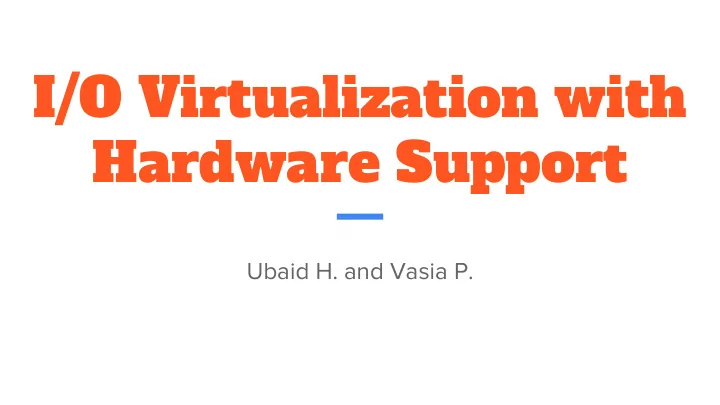

I/O Virtualization with Hardware Support Ubaid H. and Vasia P.
Trade-offs and Motivation - In a fully virtual I/O, we have interposition - Full encapsulation (store, pause, resume), portability, flexibility, live migration - Slow performance - Paravirtualization - Benefits of interposition, with better performance - Special drivers and configuration required - I/O Virtualization with Hardware Support - No interposition - Best performance (closest to bare metal)
Direct Device Assignment Idea: dedicate an I/O device to a specific VM, and give the VM control of the device
Direct Device Assignment Naive implementation has serious pitfalls - Device uses host-physical addresses - VM doesn’t know them - Not scalable - # physical devices << # VMs - Guest controls device, device can perform DMA at any physical location Hardware comes to the rescue - IOMMU allows for security and isolation - SRIOV allows for scalability
Protection?
IOMMU (I/O Memory Management Unit) Major chip vendors introduced IOMMUs - Intel Vt-d - AMD-Vi Main components: - DMA Remapper (DMAR) - Interrupt Remapper (IR)
IOVA Translation
1D vs 2D IOMMU
Interrupt Remapping Device can trigger interrupt by performing a DMA to a dedicated memory range - 0xFEE00000 - 0xFEEFFFFF on x86 VM can program device to perform DMA to this region, to perform arbitrary interrupts Without IR, IOMMU cannot distinguish between genuine MSI from the device, and a DMA that pretends to be an interrupt.
W/O Interrupt Remapping
With Interrupt Remapping
Scalability ? - Physical Constraints - Economical Constraints
SRIOV Enabled SRIOV (Single Devices Root I/O - Physical Function (PF) Virtualization) - Power Management - Configure/Manage VFs - Virtual Function (VF) - Multiplexing Devices At Hardware - Light Weight PCIe Function - Very Scalable Level - Performance Benefits
Performance: SRIOV - Virtual Functions - Get Rid of Device Identifier - 8 bits BUS, 8 bits Function
Problem ? Exits! - Can Devices ‘Talk’ to VM efficiently ?
Solution: Intel VT-x Hypervisor - Assigned EOI Register - Exitless Interrupts - Exit Associated with EOI - Shadow IDT - Can Give Write Permissions - Control Bit - External to VM for EOI ? Old LAPIC! Interrupt Exiting - x2APIC - Bitmap - Trap and Emulate - Model Specific Registers - Some Security Measures (MSR) Caveat: - Assumption that all interrupts arriving at a core belong to VMs running on it - Some Security Measures.
Performance: Intel VT-x Hypervisor
Are We Done ? No ! - Same Core - Increased Complexity of Hypervisor - ELI - All or Nothing Solution: - Posted Interrupts - APICv - CPU Posted Interrupts - IOMMU Posted Interrupts
Intel APIC Virtualization (APICv) - Acknowledgement and Receipt of Interrupts at guests without Hypervisor - Virtual APIC Page - vIRR, vISR, vEOI, vICR Registers - Hardware Emulation - Support for Posted Interrupts - Exit
CPU Posted Interrupts - Interrupts that are directly injected by the Hypervisor to a Guest on a Different Core
IOMMU Posted Interrupts
Final Remarks - IOMMU and SRIOV allow for safe and scalable direct device assignment - Exitless/Posted Interrupts enable Direct Interrupt Delivery (Bare Metal Performance) - Direct Device I/O gives up I/O interposition
?
Recommend
More recommend